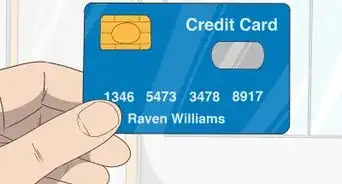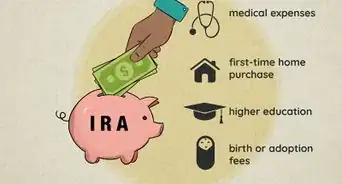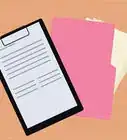This article was co-authored by Michael R. Lewis. Michael R. Lewis is a retired corporate executive, entrepreneur, and investment advisor in Texas. He has over 40 years of experience in business and finance, including as a Vice President for Blue Cross Blue Shield of Texas. He has a BBA in Industrial Management from the University of Texas at Austin.
This article has been viewed 67,234 times.
When attempting to secure a collateral loan, it may be possible to make use of the balance in a pension fund as the security for that loan. In many nations, including the United States, there are restrictions on how and even if a pension can be used as collateral, making it necessary to work with lenders to determine if this is an option. When the balance of the fund can be utilized as collateral, there are normally a series of steps that must be taken to qualify the asset and determine if it meets the criteria established by the lender.
Steps
Determining Whether You Can Use Your Pension as Collateral
-
1Determine what type of retirement plan you have. Look at any retirement plan documents you have to determine if your plan is a 401(k) or an IRA. If you have an IRA, you cannot use your retirement plan as collateral for a loan. The IRS considers this to be a "prohibited transaction." You also cannot borrow from your IRA. However, if you have a 401(k) you may be able to borrow against your plan.[1]
- You may be able to get around this by using a 401(k) transfer to transfer money from your IRA into a 401(k). To do so requires that you have a 401(k) with your employer and that you get the consent of your 401(k) administrator. This may not be possible, depending on your plan.[2] Consult with a financial professional for more information.
-
2Read your pension plan. While most plans do not allow the use of retirement balances as collateral for a loan, some plans do allow borrowing. Those that do typically only allow borrowing under strict guidelines and limitations. You should always consult with a legal professional to make sure that you are reading and understanding the wording of your retirement plan properly before using it as collateral for a loan.
- Some plans only allow you to take out a loan with the plan as collateral if you face certain hardships or meet other criteria.[3]
Advertisement -
3Learn about repayment requirements. Many, if not all, plans specify that the loan must be paid back in under five years using equal payments. Failure to repay the loan within the agreed-upon schedule may subject the borrower to income tax and a 10% penalty for early withdrawal.
Borrowing From Your Retirement Plan
-
1Understand who you will be borrowing from. When you take out this type of loan, you will essentially be borrowing from yourself. The money that you are using is the money in your own pension plan. Similarly, any interest paid will be going back to you. Take this into consideration when deciding whether or not to take out a 401(k) loan.[4]
- Borrowing from your own plan in this way is much simpler than the alternative, which is using your funds as collateral for a third-party loan. Collateralizing a third-party loan with pension funds would mean that you would not withdraw the funds, merely pledge them.
- Under ERISA, qualified plans cannot be pledged or assigned, so the lender cannot obtain or enforce a security interest. This makes borrowing from a third-party in this way difficult.
- Most lenders will not accept a pledge of retirement plan for collateral, as it is difficult to foreclose on the collateral in the event of default.
-
2Know the risks of borrowing from your pension. Loan balances that go unpaid may be treated as withdrawals. This would leave you responsible for income tax on the loan balance and a 10 percent early-withdrawal penalty if you are under the age of 59.5. In addition, interest paid on your loan is effectively taxed twice. The first time is when the interest is paid (using your after-tax dollars) and the second is when you take the money out in your retirement.
- For example, if you take out a $40,000 loan from your retirement plan and pay $3,000 in interest on it, you will be paying back the interest with your income, which has already been taxed.
- Later, in your retirement, this $3,000 will be withdrawn again as part of your retirement benefits. At this point, it will be taxed again.
- The $3,000 will then have been effectively taxed as income twice.[5]
-
3Figure out how much your plan will allow you to borrow. At most, the IRS allows borrowers taking out a loan against their retirement plan to borrow up to $50,000 or 50 percent of their retirement plan, whichever is smaller. This loan must be paid back with interest. If you quit your job before repaying the loan, you must repay the full balance within 60 days.[6]
- If this amount is less than you need to borrow, you will have to seek other loan options. This loan ceiling cannot be raised.
Taking Out Your Loan
-
1Fill out the loan application. To get started, you'll have to fill out loan paperwork with your 401(k) plan. This will require you to specify exactly how much you are borrowing as well as the reasons for the withdrawal and sign a contract promising to pay it back under certain guidelines. Be sure not to sign anything yet, even if you have filled out your loan application completely. You'll need to make absolutely sure that you are filling it out right and understand every provision of the agreement.
-
2Have a lawyer look over the loan agreement thoroughly before signing anything. You should have a legal professional examine the loan agreement for any provisions that you may be unaware of and to be sure that the loan is being taken out in a legal fashion. Have your lawyer explain any contract sections or provisions that you are unsure about.
-
3Check to see if the interest can be deducted. In many cases, interest on this type of loan is not tax deductible. However, in some rare cases, and depending on the loan agreement, your interest may be tax deductible. Consult with you lawyer to determine whether or not this is the case.
- If this is the case, you may be able to maximize your returns by paying back a maximum amount of interest on your loan. Consult with a certified public accountant (CPA) for more information.
-
4Be sure to repay the loan. As previously mentioned, failing to repay this type of loan can leave you with several different types of penalties to pay. In addition, you will have less money available for retirement. This type of loan is always required to be paid in full within five years, so keep that in mind when considering your ability to repay the loan.
- If you are using the loan to purchase a primary residence, however, you may have up to 10 years to pay the loan back.
Expert Q&A
-
QuestionI have two QDRO'd pensions from my divorce. Can I use them for collateral on a personal loan?
 Michael R. LewisMichael R. Lewis is a retired corporate executive, entrepreneur, and investment advisor in Texas. He has over 40 years of experience in business and finance, including as a Vice President for Blue Cross Blue Shield of Texas. He has a BBA in Industrial Management from the University of Texas at Austin.
Michael R. LewisMichael R. Lewis is a retired corporate executive, entrepreneur, and investment advisor in Texas. He has over 40 years of experience in business and finance, including as a Vice President for Blue Cross Blue Shield of Texas. He has a BBA in Industrial Management from the University of Texas at Austin.
Business Advisor A Qualified Domestic Relations Order (QDRO) effectively splits a retirement plan between two payees: the plan participant and a spouse, former spouse, or child of the participant. Effectively, the spouse or former spouse is bound under the same requirements of the plan as if they were the original beneficiary. Check with your plan administrator to determine whether using the plan balance as collateral is possible and the conditions required to do so. Be sure to check with potential lenders regarding their willingness to accept plan balances as collateral.
A Qualified Domestic Relations Order (QDRO) effectively splits a retirement plan between two payees: the plan participant and a spouse, former spouse, or child of the participant. Effectively, the spouse or former spouse is bound under the same requirements of the plan as if they were the original beneficiary. Check with your plan administrator to determine whether using the plan balance as collateral is possible and the conditions required to do so. Be sure to check with potential lenders regarding their willingness to accept plan balances as collateral. -
QuestionI'm getting a lump sum in June or July 2016 but I need to get a loan at the first of the year to pay my debts off. Is there any way to get a loan against the sum?
 Michael R. LewisMichael R. Lewis is a retired corporate executive, entrepreneur, and investment advisor in Texas. He has over 40 years of experience in business and finance, including as a Vice President for Blue Cross Blue Shield of Texas. He has a BBA in Industrial Management from the University of Texas at Austin.
Michael R. LewisMichael R. Lewis is a retired corporate executive, entrepreneur, and investment advisor in Texas. He has over 40 years of experience in business and finance, including as a Vice President for Blue Cross Blue Shield of Texas. He has a BBA in Industrial Management from the University of Texas at Austin.
Business Advisor Check with your plan administrator to determine whether borrowing from the plan is possible and the conditions required for a loan.
Check with your plan administrator to determine whether borrowing from the plan is possible and the conditions required for a loan.
References
- ↑ http://finance.zacks.com/can-retirement-accounts-used-collateral-10466.html
- ↑ http://www.wisestockbuyer.com/2012/06/can-you-use-ira-accounts-as-collateral/
- ↑ http://finance.zacks.com/can-retirement-accounts-used-collateral-10466.html
- ↑ http://www.wisestockbuyer.com/2012/06/can-you-use-ira-accounts-as-collateral/
- ↑ http://www.investopedia.com/articles/retirement/05/retirementloan.asp
- ↑ http://finance.zacks.com/can-retirement-accounts-used-collateral-10466.html












-Step-9-Version-2.webp)















-Step-9-Version-2.webp)




































